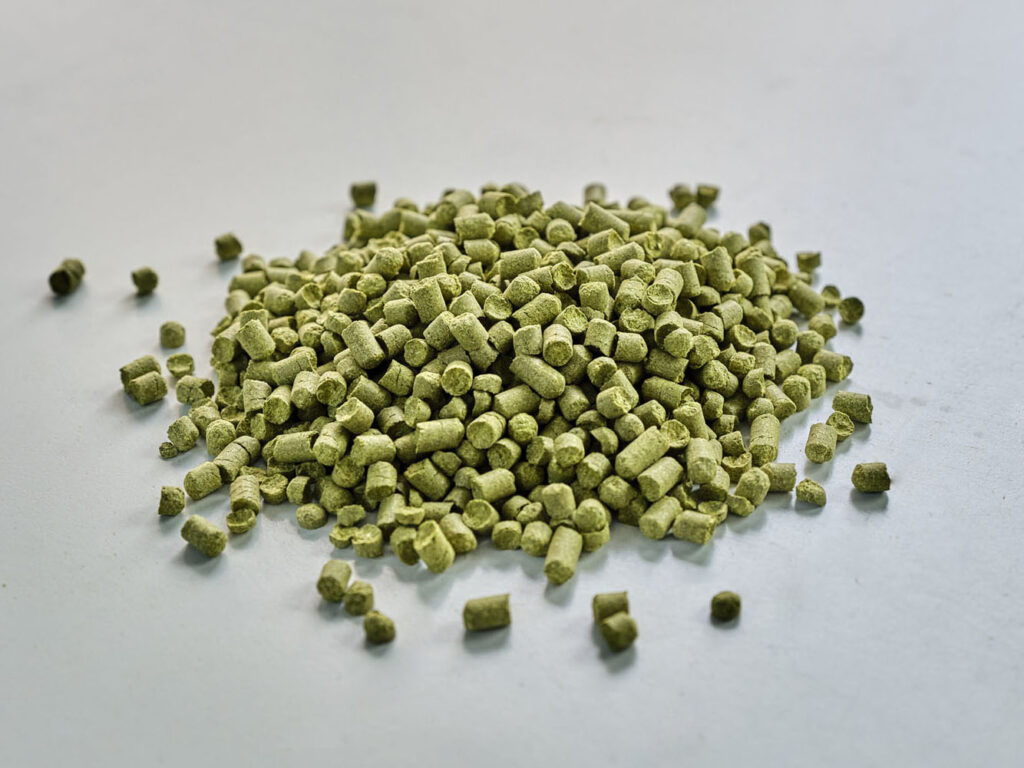Hops
Natural product and our raw material
Hops is a perennial climbing shrub from the botanical family of hemp.
The cultivated plant (lat. Humulus lupulus) gives beer aroma, bitterness and shelf life and is the result of centuries of cultivation.
In this form, the hops are grown worldwide and varietal.
The largest contiguous hop-growing area is the Hallertau, the location of the Hopfenveredlung St. John.

The products of the
Hopfenveredlung
St. Johann
The products are divided into enriched (type 45) and non-enriched pellets (type 90).
The type designation can be traced back to the original method of quantity yield. If 100 kilograms of raw hops were processed into type 90, the yield was approx. 90 kilograms, and into type 45 approx. 45 kilograms.
Today, these types are defined with the help of alpha standardization, which meets individual product requirements. The product is specifically enriched with the hop oil lupulin by reducing components such as leaf and stem in the course of processing.
Hop pellets
Hop pellets are the most common form of hop use in breweries. Here we distinguish between non-enriched pellets (type 90) and lupulin-enriched pellets (type 45), as well as isomerized pellets. The type designations can be traced back to the original method of quantity yield. If 100 kg of raw hops were processed into type 90, about 90 kg of product were obtained, while type 45 yielded about 45 kg of product. Today, these types are defined with the help of alpha standardization, which meets individual product requirements.
The type designations were retained.
Compared to raw hops, hop pellets have higher homogeneity, better storage stability and reduce storage and transport costs. They produce an aroma identical to that of raw hops.

Non-enriched pellets
Pellets of this type are not standardized and their quality characteristics correspond to those of the raw hops used.
Lupulin enriched pellets
These are standardized pellets, the hop bitter acids and hop oil are concentrated by enriching the lupulin.
Isomerized pellets
In isomerized hop pellets (type 90 or type 45), the α-acids contained are almost completely converted to iso-α-acids.
Hop extract
CO2-Hop extract is a homogeneous, viscous natural product without chemical additives. Its texture is honey/resinous. Depending on the hop variety, the color varies from yellow to dark green and the consistency at room temperature from counting liquid to solid.
It is a concentrated hop product with excellent storage stability, which is a practical alternative to raw hops or hop pellets due to its easy dosing. Depending on when the extract is added in the brewing process, it brings either the bitterness or the hop aroma to the beer.

CO2-pure resin extract
In the CO2extract contains all brewing-relevant substances of hops such as α-acids, β-acids and hop oils.
Isomerized Kettle Extract
Here, the α-acid is present in isomerized form (iso-α-acid). The starting product is the CO2-Hop extract.
During extraction, two fractions, thus two different products, can be produced.
Oil-enriched CO2-extract
This fraction contains the easily soluble hop oils and aroma substances.
Oil-reduced CO2-extract
This fraction contains the poorly soluble resins and waxes, the bitter substances.